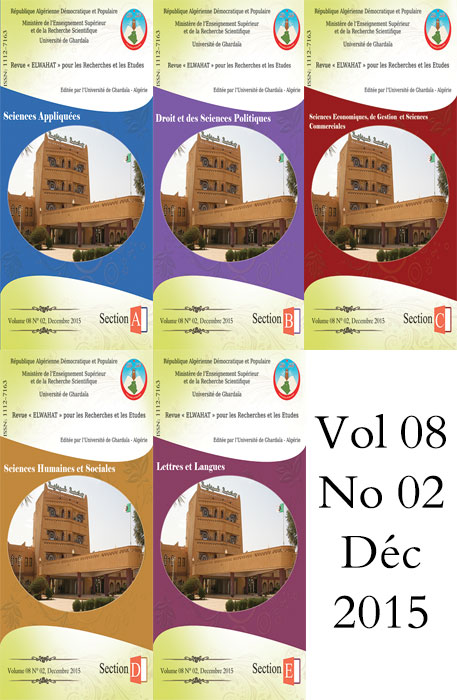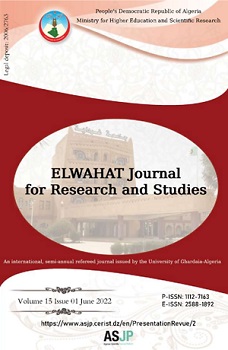Etude de l’activité biologique des extraits aqueux d’Euphorbia guyoniana (Euphorbiaceae) récoltée dans Oued Sebseb (Sahara Algérien)
Abstract
The study focuses on the toxicity of leaf extracts of Euphorbia guyoniana Boiss. & Reut (Euphorbiaceae), harvested in Oued sebseb, northern Sahara eastern Algeria on some bacterial and fungal strains. The crude extract of Euphorbia guyoniana has low antibacterial activity for Staphylococcus aureus with an area of 8.5 mm, and Escherichia coli is 7.67 mm; Protus mirabilis for 7mm; and Micrococci lutus and Bacillus subtilis by 6mm inhibition zone, and therefore also for the other dilutions were labeled low less antimicrobial activity of 8mm, except for Staphylococcus aureus resulting in a 9.33 mm zone of inhibition with the 10-6 and 10-4 with 8.33 dilution. The study of the antimicrobial activity of aqueous extracts of E. guyoniana reveals weak antimicrobial activities. Keywords: Euphorbia guyoniana, aqueous extract, antimicrobial activity, Sahara.References
Abdollahi M., Karimpour H. Et Monsef-Esfehani Hr. 2003. -Antinociceptive effects of Teucrium polium L. total extract and essential oil in mouse writhing test. Pharmacological Research, Vol. 48:31–35.
Balansard G., 2007. -Analyse critique des protocoles pharmacologiques utilisés pour larecherche d'extraits et de substances pures d'origine végétale à propriétés Antibactérienneou antiparasitaire. Revue ethnopharmacologie.42
Belaiche, P. 1979- "L'aromatogramme". Traité de phytothérapie etd'aromathérapie. M. S. A. Editeur. Paris. Tome 1: 204.
De Nazaré D. M. M., Sebastião F. Palmeira J., Conserva L. M. And Lyra Lemos R. P., 2005. Quinoline alkaloïds from Sebastiania corniculata (Euphorbiaceae). Biochemical Systematics and Ecology, vol. 33 (5): 555-558.
Fattorusso E. and Taglialatela-Scafati O., 2007. - Modern Alkaloids. Structure, Isolation, Synthesis and Biology. Ed. WILEY-VCH Verlag GmbH & Co. KGaA, Weinheim, République Fédérale d'Allemagne, 691p.
Fazeli, M. R., Amin, G., Ahmadian-Attari, M. M., Ashtiani, H., Jamalifar, H., Samadi, N. 2007.- Antimic robial activities of Iranian sumac and avishan-e shirazi (Zataria multiflora) against some food -borne bacteria. Food Control 18: 646 -649.
Fernandez-Lopez, J., Zhi, N., Aleson-Carbonell, L., Perez-Alvarez, J.A., Kuri, V. 2005.- Antioxidant and antibacterial activities of natural extracts: application in beef meatballs.Meat Science. 69: 371 -380.
Ferrari, J. 2002.- Contribution à la connaissance du métabolisme secondaire desThymelaeaceae et investigation phytochimique de l’une d’elles: Gnidia involucrata Steud.ex A. Rich. Thèse de doctorat. Lausanne.
Garbonnelle., Dens F., Marmonier A., Pinon G., Et Vargues R., 1987-Bactériologie médicale Techniques usuelles. SIMEP, Paris. France.
Haba H., Lavaud C., Harkat H., Alabdul Magid A., Marcourt L., Benkhaled M., 2007. Diterpenoids and triterpenoids from Euphorbia guyoniana.Phytochemistry, vol. 68: 1255-1260.
Haba H.,2008.Etude phytochimique de deux Euphorbiaceae sahariennes: Euphorbia guyoniana Boiss. & Reut. et Euphorbia retusa Forsk. Thèse de doctorat en sciences, université de Batna, p.160.305.
Hostettmann K 1982.-Tout savoir sur le pouvoir des plantes. Ed. Favre. S.A Lausanne. Suisse.
Hunsa P.,Chulabhorn M.,Ruchirawat S., Prawat U., Tuntiwachwuttikul P., Tooptakong U., Taylor W. C., Pakawatchai C., Brian W., Skelton and Allen H., 1995.White Cyanogenic and non-cyanogenic glycosides from Manihot esculenta. Phytochemistry, vol.40 (4): 1167-1173.
Joffin N. et Leyral G., 2001-Microbiologie Technique, Dictionnaire des techniques. 3éme Ed, Bordeaux : 320.
Koba K., Sanda K., Raynaud C., Nenonene Y.A., Millet J. & Chaumont Loziene, K., Venskutonis, P. R., Sipailiene, A., Labokas, J. 2007.- Radical scavenging and antibacterial properties of the extracts from different Thymus pulegioides L. chemotypes Food chem. 103: 546-559.
Mavar M. H., Brick D., Marie D. E. P. And Quetin-Leclercq J., 2004. In vivo anti-inflammatory activity of Alchornea cordifolia (Schumach. & Thonn.) (Euphorbiaceae). Journal of Ethnopharmacologym, vol. 92 (2-3): 209-214.
Mazoir N., Benharref A., Bailén M., Reina M., and Onzálezcoloma A., 2008. Bioactive triterpene derivatives from latex of two Euphorbia species. Phytochemistry, vol. 69: 1328–1338.from Euphorbia geniculata. Phytochemistry, vol. 19 (10): 2163-2166.
Mohammedi Z., 2006. Etude du pouvoir antimicrobien et antioxydant de quelques plantes de la région de Tlemcen. Thèse de magister. Option: Produits naturels, activité biologique et synthèse. Faculté des Sciences. Université ABB. Tlemcen. Algérie.
Moreira, M.R., Ponce, A.G., Del Valle, C.E., Roura, S.I. 2005.- Inhibitory parameters of essential oils to reduce a foodborne pathogen. LWT. 38: 565 -570.
Øyvind M. A. and Kenneth R. M., 2006. - Flavonoids. Chemistry, Biochemistry and Applications. Ed. CRC Press, Taylor & Francis Group- USA, 1212 p.
Pibiri M. C., 2005.- Assainissement microbiologique de l'air et des systèmes de ventilation au moyen d'huiles essentielles. Thèse de doctorat, Ecole Polytechnique Fédérale de Lausanne, 160 p.
Tripathi R. D. and Tiwari K. P., 1980. - Geniculatin, a triterpenoid saponin
Zellagui Amar., Said Noamane Labib ., Gherraf Noureddine. and Rhouati Salah., 2012.-Phytochemical screening of five Algerian plants and the assessment of the antibacterial activity of two Euphorbia guyoniana extracts 4 (5):1438-1444.
J.P. (2004). Activities antimicrobiennes d’huiles essentielles de trois Cymbopogon sp. Vis-à- vis des germes pathogènes d’animaux de compagnie. Annales de Médecine Vétérinaire, 148, 202-206.
Balansard G., 2007. -Analyse critique des protocoles pharmacologiques utilisés pour larecherche d'extraits et de substances pures d'origine végétale à propriétés Antibactérienneou antiparasitaire. Revue ethnopharmacologie.42
Belaiche, P. 1979- "L'aromatogramme". Traité de phytothérapie etd'aromathérapie. M. S. A. Editeur. Paris. Tome 1: 204.
De Nazaré D. M. M., Sebastião F. Palmeira J., Conserva L. M. And Lyra Lemos R. P., 2005. Quinoline alkaloïds from Sebastiania corniculata (Euphorbiaceae). Biochemical Systematics and Ecology, vol. 33 (5): 555-558.
Fattorusso E. and Taglialatela-Scafati O., 2007. - Modern Alkaloids. Structure, Isolation, Synthesis and Biology. Ed. WILEY-VCH Verlag GmbH & Co. KGaA, Weinheim, République Fédérale d'Allemagne, 691p.
Fazeli, M. R., Amin, G., Ahmadian-Attari, M. M., Ashtiani, H., Jamalifar, H., Samadi, N. 2007.- Antimic robial activities of Iranian sumac and avishan-e shirazi (Zataria multiflora) against some food -borne bacteria. Food Control 18: 646 -649.
Fernandez-Lopez, J., Zhi, N., Aleson-Carbonell, L., Perez-Alvarez, J.A., Kuri, V. 2005.- Antioxidant and antibacterial activities of natural extracts: application in beef meatballs.Meat Science. 69: 371 -380.
Ferrari, J. 2002.- Contribution à la connaissance du métabolisme secondaire desThymelaeaceae et investigation phytochimique de l’une d’elles: Gnidia involucrata Steud.ex A. Rich. Thèse de doctorat. Lausanne.
Garbonnelle., Dens F., Marmonier A., Pinon G., Et Vargues R., 1987-Bactériologie médicale Techniques usuelles. SIMEP, Paris. France.
Haba H., Lavaud C., Harkat H., Alabdul Magid A., Marcourt L., Benkhaled M., 2007. Diterpenoids and triterpenoids from Euphorbia guyoniana.Phytochemistry, vol. 68: 1255-1260.
Haba H.,2008.Etude phytochimique de deux Euphorbiaceae sahariennes: Euphorbia guyoniana Boiss. & Reut. et Euphorbia retusa Forsk. Thèse de doctorat en sciences, université de Batna, p.160.305.
Hostettmann K 1982.-Tout savoir sur le pouvoir des plantes. Ed. Favre. S.A Lausanne. Suisse.
Hunsa P.,Chulabhorn M.,Ruchirawat S., Prawat U., Tuntiwachwuttikul P., Tooptakong U., Taylor W. C., Pakawatchai C., Brian W., Skelton and Allen H., 1995.White Cyanogenic and non-cyanogenic glycosides from Manihot esculenta. Phytochemistry, vol.40 (4): 1167-1173.
Joffin N. et Leyral G., 2001-Microbiologie Technique, Dictionnaire des techniques. 3éme Ed, Bordeaux : 320.
Koba K., Sanda K., Raynaud C., Nenonene Y.A., Millet J. & Chaumont Loziene, K., Venskutonis, P. R., Sipailiene, A., Labokas, J. 2007.- Radical scavenging and antibacterial properties of the extracts from different Thymus pulegioides L. chemotypes Food chem. 103: 546-559.
Mavar M. H., Brick D., Marie D. E. P. And Quetin-Leclercq J., 2004. In vivo anti-inflammatory activity of Alchornea cordifolia (Schumach. & Thonn.) (Euphorbiaceae). Journal of Ethnopharmacologym, vol. 92 (2-3): 209-214.
Mazoir N., Benharref A., Bailén M., Reina M., and Onzálezcoloma A., 2008. Bioactive triterpene derivatives from latex of two Euphorbia species. Phytochemistry, vol. 69: 1328–1338.from Euphorbia geniculata. Phytochemistry, vol. 19 (10): 2163-2166.
Mohammedi Z., 2006. Etude du pouvoir antimicrobien et antioxydant de quelques plantes de la région de Tlemcen. Thèse de magister. Option: Produits naturels, activité biologique et synthèse. Faculté des Sciences. Université ABB. Tlemcen. Algérie.
Moreira, M.R., Ponce, A.G., Del Valle, C.E., Roura, S.I. 2005.- Inhibitory parameters of essential oils to reduce a foodborne pathogen. LWT. 38: 565 -570.
Øyvind M. A. and Kenneth R. M., 2006. - Flavonoids. Chemistry, Biochemistry and Applications. Ed. CRC Press, Taylor & Francis Group- USA, 1212 p.
Pibiri M. C., 2005.- Assainissement microbiologique de l'air et des systèmes de ventilation au moyen d'huiles essentielles. Thèse de doctorat, Ecole Polytechnique Fédérale de Lausanne, 160 p.
Tripathi R. D. and Tiwari K. P., 1980. - Geniculatin, a triterpenoid saponin
Zellagui Amar., Said Noamane Labib ., Gherraf Noureddine. and Rhouati Salah., 2012.-Phytochemical screening of five Algerian plants and the assessment of the antibacterial activity of two Euphorbia guyoniana extracts 4 (5):1438-1444.
J.P. (2004). Activities antimicrobiennes d’huiles essentielles de trois Cymbopogon sp. Vis-à- vis des germes pathogènes d’animaux de compagnie. Annales de Médecine Vétérinaire, 148, 202-206.
Issue
Section
A- Applied Sciences






